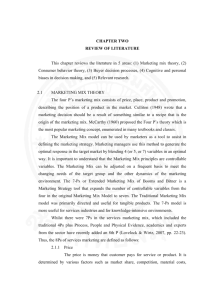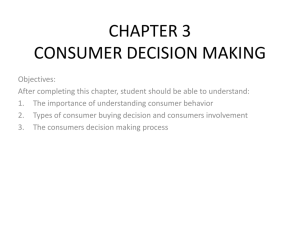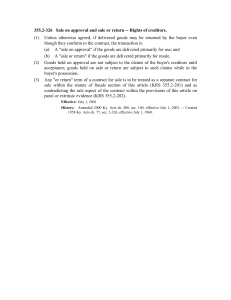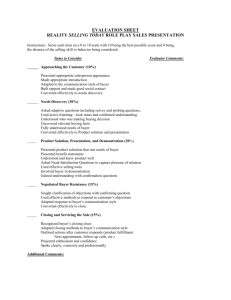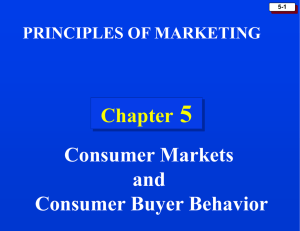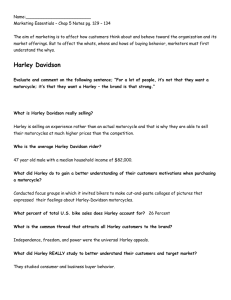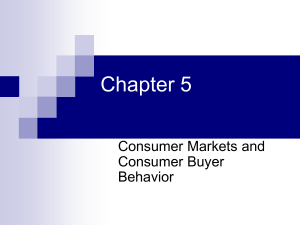topic vi: application of social psycology to consumer behaviour
advertisement
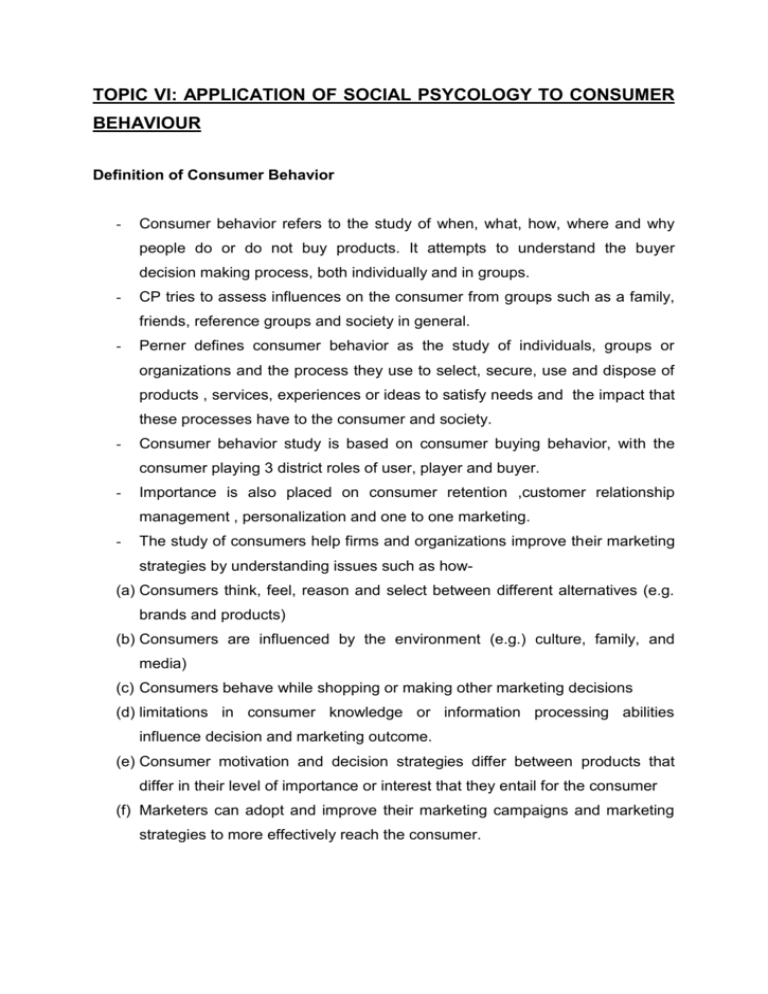
TOPIC VI: APPLICATION OF SOCIAL PSYCOLOGY TO CONSUMER BEHAVIOUR Definition of Consumer Behavior - Consumer behavior refers to the study of when, what, how, where and why people do or do not buy products. It attempts to understand the buyer decision making process, both individually and in groups. - CP tries to assess influences on the consumer from groups such as a family, friends, reference groups and society in general. - Perner defines consumer behavior as the study of individuals, groups or organizations and the process they use to select, secure, use and dispose of products , services, experiences or ideas to satisfy needs and the impact that these processes have to the consumer and society. - Consumer behavior study is based on consumer buying behavior, with the consumer playing 3 district roles of user, player and buyer. - Importance is also placed on consumer retention ,customer relationship management , personalization and one to one marketing. - The study of consumers help firms and organizations improve their marketing strategies by understanding issues such as how- (a) Consumers think, feel, reason and select between different alternatives (e.g. brands and products) (b) Consumers are influenced by the environment (e.g.) culture, family, and media) (c) Consumers behave while shopping or making other marketing decisions (d) limitations in consumer knowledge or information processing abilities influence decision and marketing outcome. (e) Consumer motivation and decision strategies differ between products that differ in their level of importance or interest that they entail for the consumer (f) Marketers can adopt and improve their marketing campaigns and marketing strategies to more effectively reach the consumer. - Belch and Belch define consumer behavior as a process and activities people engage in when searching for, selecting, purchasing, using evaluating and disposing of products and services so as to satisfy their needs and desires. Models of Consumer Decision Making The Black Box Model - The black box model shows the interaction of stimuli, consumer characteristics, decision process and consumer responses. The focus is not set on the process inside a consumer, but relationship between the stimuli and the response of the consumer. - The marketing stimuli are planned and processed by the companies, whereas the environmental stimuli are given by social factors, based on the economical , political and cultural circumstances of a society. The buyers black box contains the buyer characteristics and the decision process, which determines the buyer’s response. - The black box model considers the buyers`, response as a result of conscious, rational decision process in which it is assumed that the buyer has recognized the problem however , in reality many decisions are not made in awareness of a determined problem by a consumer. BUYER`S BLACK BOX marketing environmental buyer`s decision buyer`s response stimuli stimuli characteristics process product economic attitudes problem recogn product choice place technological motivation info search brand choice promotion political perceptions alternative dealer choice evaluation price cultural personality purchase purchase timing decision demographics lifestyle Post purchase Purchase amount behavior natural knowledge Internal Influences - Consumer behavior is influenced by: demographics, psychographics, (lifestyle), personality, motivation, knowledge, attitudes, beliefs, feelings. External Influence - Culture, sub- culture, locality, royalty, ethnicity, family, social class, reference group. (1) Problem Recognition - One has to realize that something is not as it should be e.g. car is getting more difficult to start and not accelerating well. (2) Information Search - The second step- what are some alternative ways of solving the problem – e.g. buy a new car, a used car, repair, ride bicycle etc. - According to Belch and belch (2007) consumers undertake both an internal (memory) and external search. - Internal search involves the consumer identifying alternatives from his or her memory. E.g. few people will search the yellow pages for fast food restaurants – consumer just retrieves information from memory (low environment goods) - For high involvement products , consumers are more likely to use external search – before buying a car consumer may also ask friends opinions. - Firms that make products that are selected predominantly through external search must invest in having information available to the consumer in need e.g. though brochures (3) Alternative evaluation - Consumer compares the brands and products that are in their evoked set. Consumers evaluate alternatives in terms of the functional and physical benefits consumers are seeking and therefore which attributes are most important in terms of making a decision (4) Purchase Decision - once the alternatives have been evaluated the consumer is ready to make a purchase decision - Sometimes purchase intention does not result in actual purchase. The marketing organization must facilitate the consumer to act on their purchase intention. The provision of credit or payment terms may encourage purchase. The relevant internal physical process that is associated with purchase decision in integration Post purchase Evaluation - It is common for customers to experience concerns after making a purchase decision. This arises form a concept that is known as cognitive dissonance. The customer after buying a product may feel that an alternative would be preferable in that circumstance the customer will purchase immediately. THE AIUAPR MODEL - This is a very simple model, and as such apply quite generally. Its lessons are that you cannot obtain repeat purchases without going through the stages of building awareness and then obtaining trial use, which has to be successful. - It is a pattern which applies to all repeat purchase products and services. (1) Awareness – before anything else the potential customers must become aware that the product or services exists. If audience never hears the message, they will not act on it. (2) Interest – it is not sufficient just to grab attention. Message must interest them and persuade them that the product or service is relevant to their needs. (3) Understanding- once an interest is established. The prospective customer must be able to appreciate how well the offering may meet his /her needs. (4) Attitudes – the message must go further, to persuade the reader to adopt a sufficiently positive attitude towards the product or service that he/she will purchase it. (5) Purchase – the above stages may take a few minutes – the final buying decisions, may take place some time later, perhaps weeks later, when the prospective buyer actually tries to find a shop which stocks the products. (6) Repeat Purchase – only if the experience is a success for the customer will it be turned into repeat purchases .It is these repeats, not the single purchase which is the focus of most models. COGNITIVE AND PERSONAL BIASES IN DECISION MAKING. Biases can creep into our decision making processes, making one question the correctness of a decision. (1) Selective search for evidence – we tend to be willing to gather facts that support certain conclusions but disregard other facts that support different conclusions. (2) Premature termination of search evidence - we tend to accept the first alternative that looks like it might work. (3) Conservation and inertia – unwillingness to ∆ thought patterns that we have used in the past in the face of new circumstances. (4) Selective perception – we actively screen out information that we do not think is salient (5) Recency- we tend to place more attention on more recent information and either ignore or forget distant life. (6) Repetition bias- a tendency to believe what we have been told most often and by the greatest of services. (7) Group think- peer pressure to conform to group opinion (8) Source credibility bias- we reject something if we have a bias towards the person or organization. (Tiger Web) (9) Role Fulfillment- we conform to the decision making expectations that others have of someone in our position 10)Assumption of causality - we tend to ascribe causation even only when the evidence only suggest correlation. # Attitude and Attitude change # Customer socialization.
